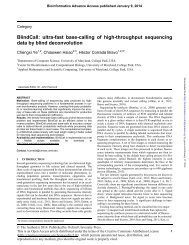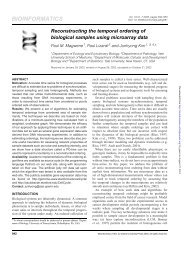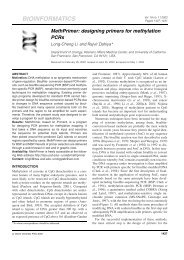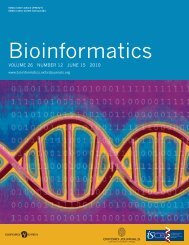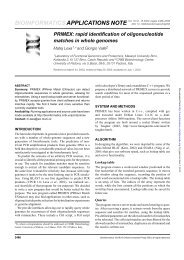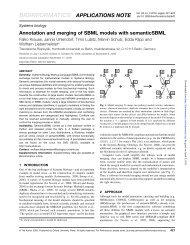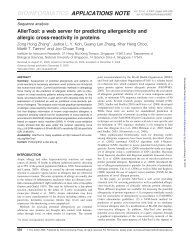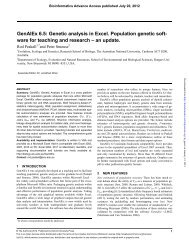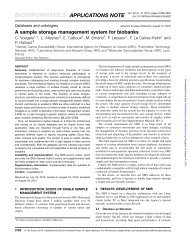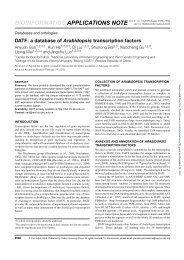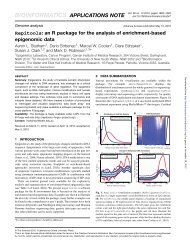SPEM: improving multiple-sequence alignment with sequence ...
SPEM: improving multiple-sequence alignment with sequence ...
SPEM: improving multiple-sequence alignment with sequence ...
You also want an ePaper? Increase the reach of your titles
YUMPU automatically turns print PDFs into web optimized ePapers that Google loves.
Zhou and Zhou<br />
Query<br />
Query<br />
Sequence 1 Sequence 2<br />
PSIBLAST<br />
PSIPRED<br />
SP<br />
2<br />
for pairwise <strong>sequence</strong> <strong>alignment</strong><br />
Seq. Profile<br />
Secondary−structure−<br />
dependent Gap<br />
Penalties<br />
2nd. Struc. 2nd. Struc. PSIPRED<br />
Dynamic<br />
Programming<br />
Optimized Seq.<br />
Alignment<br />
Seq. Profile<br />
PSIBLAST<br />
Fig. 1. The flow chart of SP 2 for pairwise <strong>sequence</strong> <strong>alignment</strong>.<br />
<strong>SPEM</strong> improves <strong>alignment</strong> of remote homologs over other leading<br />
methods while maintaining the accuracy of aligning homologs.<br />
2 METHODS<br />
SP2 for pairwise <strong>sequence</strong> <strong>alignment</strong><br />
The method for SP2 (Zhou & Zhou, 2005a) has been described elsewhere.<br />
Here, we give a brief summary for completeness. The algorithm of<br />
SP2 for a pairwise <strong>sequence</strong>-<strong>sequence</strong> <strong>alignment</strong> is shown in Fig. 1. The<br />
details are as follows.<br />
First, the program PSIBLAST (Altschul et al., 1997) is used to search<br />
homologous <strong>sequence</strong>s of a query <strong>sequence</strong> from the NCBI non-redundant<br />
(NR) database (ftp://ftp.ncbi.nih.gov/blast/db/FASTA/nr.gz). As in PSI-<br />
PRED (Jones, 1999), the NR database was filtered to remove low-complexity<br />
regions, transmembrane regions, and coiled-coil segments before being<br />
searched by PSIBLAST. This homolog search is conducted <strong>with</strong> an Evalue<br />
cutoff of 0.001 and completed after three iterations. The homologous<br />
<strong>sequence</strong>s found by PSIBLAST are then filtered by keeping only those<br />
<strong>sequence</strong>s that have less than 98% identity <strong>with</strong> the query <strong>sequence</strong> and<br />
an E-value of less than 0.001. The filtered homologs are used to produce<br />
the <strong>sequence</strong> profile that characterizes evolutionary-derived probability of a<br />
residue type at a given query <strong>sequence</strong> position .<br />
Second, PSIPRED (Jones, 1999) is used to predict the secondary structure<br />
of a query <strong>sequence</strong>. Three states (helix, strand, coil) are used for all<br />
secondary structures.<br />
Third, two query <strong>sequence</strong>s are aligned <strong>with</strong> a total matching score given<br />
by the following equation:<br />
S(i, j) = − 1<br />
2<br />
h<br />
F seq<br />
q1<br />
(i) · Mseq<br />
q2 (j) + Fseq<br />
q2 (j) · Mseq<br />
q1 (i)<br />
i<br />
−w2ndaryδsi,sj + sshift, (1)<br />
where F seq<br />
qk (i) is the <strong>sequence</strong>-derived frequency profile of query <strong>sequence</strong><br />
k (<strong>sequence</strong> profiles described above), M seq<br />
qk (j) is the log odd profile<br />
(position-specific substitution matrix as in PSIPRED) of query <strong>sequence</strong> k<br />
produced by the above mentioned PSIBLAST search against the filtered NR<br />
database, sshift is a to-be-determined constant shift, w2ndary is a weight<br />
parameter for secondary structure profiles, and δsi,sj is a simple function of<br />
the secondary structure element si of query <strong>sequence</strong> 1 at <strong>sequence</strong> position<br />
i and sj of the query <strong>sequence</strong> 2 at <strong>sequence</strong> position j.<br />
j<br />
1 si = sj<br />
δsi,sj =<br />
−1 si �= sj.<br />
Finally, the above-mentioned matching score is optimized by using a<br />
dynamic-programming <strong>alignment</strong> algorithm <strong>with</strong>out penalty to end gaps<br />
(Needleman & Wunsch, 1970). A gap penalty that depends on secondary<br />
structures is employed. No gaps are allowed in helices or sheets (i.e., when<br />
2<br />
<strong>SPEM</strong> for <strong>multiple</strong> <strong>sequence</strong> <strong>alignment</strong><br />
N Sequences<br />
N(N−1)/2 Pairwise<br />
Alignments<br />
Consistency−based<br />
Refinement<br />
Building<br />
Guide Tree<br />
Progressive<br />
Multiple Alignment<br />
.<br />
SP 2<br />
Dynamic<br />
Programming<br />
Neighbor<br />
Joining Method<br />
Dynamic<br />
Programming<br />
Global Multiple Alignment<br />
Consistency−based<br />
Scoring Matrix,<br />
Zero−gap Penalties<br />
Sequence identity−<br />
based Scoring,<br />
Zero−gap Penalties<br />
Fig. 2. The flow chart of <strong>SPEM</strong> for <strong>multiple</strong> <strong>sequence</strong> <strong>alignment</strong>.<br />
si = sj = α or si = sj = β). The gap opening (w0) and gap extension<br />
(w1) penalties are applied to coil regions. However, no gap penalties are applied<br />
to the beginning and the end of <strong>sequence</strong>s (i.e. no end-gap penalties). To<br />
avoid a possible trivial solution of aligning end gaps to whole <strong>sequence</strong>s, a<br />
shift score sshift is used [See e.g. Wang & Dunbrack Jr. (2004)]. Alignment<br />
optimization is to minimize the total <strong>alignment</strong> score due to the negative<br />
signs in Eq. (1).<br />
The above procedure contains four unknown parameters (w0, w1,<br />
w2ndary, and sshift). In the original <strong>sequence</strong>-to-structure <strong>alignment</strong><br />
method SP2 , they were obtained by optimizing the SP2 performance on the<br />
ProSup <strong>sequence</strong>-to-structure <strong>alignment</strong> benchmark where the reference <strong>alignment</strong><br />
is from the ProSup structure-<strong>alignment</strong> program (Domingues et al.,<br />
2000). w0 = 7.8, w1 = 0.18, w2ndary = 0.73, and sshift = −1.30.<br />
Eq. (1) for the <strong>sequence</strong>-<strong>sequence</strong> <strong>alignment</strong> uses a symmetric form for<br />
F seq<br />
qk (i) and Mseq<br />
qk (j) <strong>with</strong> k = 1 and 2. This is slightly different from that<br />
used in the original SP2 for the <strong>sequence</strong>-structure <strong>alignment</strong> (the <strong>alignment</strong><br />
between a query <strong>sequence</strong> and a <strong>sequence</strong> <strong>with</strong> a known structure). The latter<br />
was from the asymmetric equation in the SP3 method (Zhou & Zhou,<br />
2005a) that built on two input <strong>sequence</strong>s having different properties (one<br />
has a known structure and the other does not). The adoption of a symmetric<br />
version in Eq. (1) is to avoid the dependence of the <strong>alignment</strong> result on the<br />
input order of <strong>sequence</strong>s. We found that this symmetric score function gives<br />
essentially the same <strong>alignment</strong> accuracy on the ProSup benchmark (Domingues<br />
et al., 2000) <strong>with</strong> the same optimized parameter values from the original<br />
<strong>sequence</strong>-structure <strong>alignment</strong> method SP2 . Thus, throughout this paper, we<br />
will use this optimized parameter set.<br />
<strong>SPEM</strong> for <strong>multiple</strong> <strong>sequence</strong> <strong>alignment</strong><br />
The above-mentioned SP2 algorithm for pairwise <strong>alignment</strong> is combined<br />
<strong>with</strong> a consistency-based scoring method for refining pairwise <strong>alignment</strong> and<br />
a progressive algorithm for <strong>multiple</strong> <strong>sequence</strong> <strong>alignment</strong>. As illustrated in<br />
Fig. 2, <strong>SPEM</strong> takes following steps for <strong>multiple</strong> <strong>alignment</strong>.<br />
(1) Pairwise <strong>alignment</strong>: Given a set of N <strong>sequence</strong>s, SP2 is used to<br />
produce all N(N-1)/2 pairwise <strong>alignment</strong>s.<br />
(2) Pairwise <strong>alignment</strong> refinement: The SP2 pairwise <strong>alignment</strong> is refined<br />
by using a consistency score. For a given pair of <strong>sequence</strong>s a and b, the consistency<br />
scoring matrix, consab (i, j) = −1 if residue a(i) is aligned <strong>with</strong><br />
b(j) by SP2 , consab (i, j) = 0 if otherwise. This matrix is then updated<br />
based on the <strong>alignment</strong> between a and the third <strong>sequence</strong> c and the <strong>alignment</strong><br />
between b and c by SP2 . If c(k) is aligned <strong>with</strong> a(m) and <strong>with</strong> b(n),<br />
Downloaded from<br />
http://bioinformatics.oxfordjournals.org/<br />
by guest on November 24, 2012



